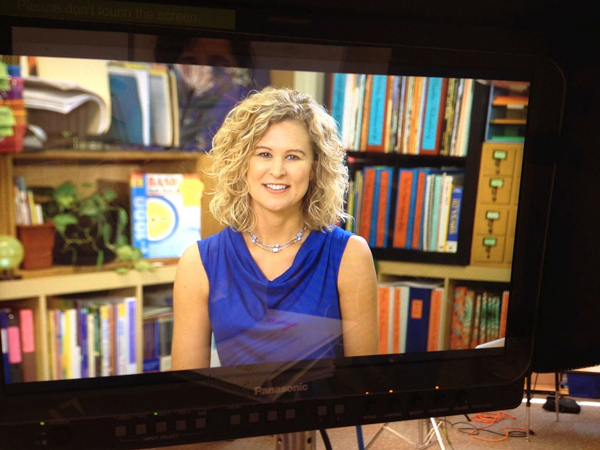
Sarah hosts a show for the Teaching Channel and performs various video spots, and PSAs as she spreads the values of Open Teaching.Being a parent presents its challenges. Being a parent during the COVID-19 pandemic can present seemingly insurmountable challenges due to the strain of continuing to work and play teacher.
In addition to batting guilt, parents are wondering how to ensure their children don’t fall behind during the summer. To help us identify how, we consulted with our friend, and 2010 National Teacher of the year, Sarah Brown Wessling.
You’ve done more than you realize
First, it’s important to understand you’ve done a great job. Despite your feelings of guilt or fear that you’ve done irreparable harm to your child’s future, you’ve done more than you think. While not every lesson plan or activity may have gone off as smoothly as you’d hoped, you need to realize that not every lesson had to be planned out for your child to learn.
Sarah mentions that having an overly-structured plan, close to what would be provided in school, would likely cause stress, unrealistic expectations and would end up going by the wayside. Many students were asked to become independent learners and this also contributed to the stress you may have felt around your kitchen table.
As a working parent, you probably need to shift your focus to your job during the day. Unfortunately, this leaves your child without someone who can fully engage in their learning. Sarah calls this the difference between playing school and learning. Setting the agenda is only half of it. Engagement is what really fuels the learning.
Teaching starts with model behavior
As a parent, your child looks to you for help with understanding what’s important. You can stress importance verbally or with notes but being present during their learning helps enhance the experience. It doesn’t mean that you need to be with them all the time, but it does mean that you need to engage with them. When you engage with them, you’re not just telling them this is important, you’re showing them.
Further, when your child knows you’re “in it with them” and not just checking off the boxes, they understand learning is more than completing tasks. Sarah mentions, “one thing we see as teachers is that students are more receptive to learning when they know we care about them as people.”
So, whether it’s reading a book, doing math or even coloring, actively participate with your child. Ask what they’re curious about and pay attention. Further, model the behavior you want them to adopt.
For instance, reading over the summer is so important for your child. So, carve out 30 minutes to an hour each day for them to read. Then, make time on your schedule to do it too. By saying something like “I’m going to do my thirty minutes of reading, have you done yours?” you reinforce the importance of the action.
When you engage, you turn the chore of task completion into an opportunity to learn more from each other. Now you can read together, talk about each other’s stories, discuss character development, or even ponder potential sequel storylines.
Has my child fallen behind?
Typically, at the end of each school year a parent believes that their child should be ready for the next grade. However, now you may be worried that due to distance learning and “home schooling” your child has fallen behind. So, your ninth grader should now be ready for the 10th grade or your second grader should be ready for third grade. Sarah stresses, “that’s not always the case. Even during normal times, some students just need a little more time.”
Sarah says, “just remember, everybody is in the same boat.” You don’t need to worry. “Teachers are ready and preparing for the fall to help guide your child and fill in any gaps.”
She wants to remind parents that, “a teacher’s job is not to judge where students are, but to help them get where they need to be. It’s our job as teachers, and it’s a responsibility we take seriously.”

Sarah became certified by the National Board for Professional Teaching Standards program and currently serves on its Board of Directors.Will college admissions be impacted?
For parents of a child who is applying to college, remember that the last half of this year on your child’s transcript will look unique all over the country. Many schools, nationwide, chose a pass-fail option instead of a letter grade option. This means that while post-secondary schools will still be looking at transcripts, they’ll have to do it through the lens of this unique situation and adjust accordingly.
Here the most important thing is to try not to exacerbate fear without facts. If there is a concern, address it. Have your son or daughter reach out to their advisor and get the facts, so proper action can be taken. It’s the advisor’s job to lay out a clear path and communicating with them now will save headaches and confusion down the road.
Mental wellbeing
As we focus on bettering our children, Sarah mentions that it is so important not to overlook their mental well-being. “This is a really, really hard time for them. So, talk to them about how they’re feeling. Let them know they can talk to you about anything. Because if they shut down, they’re not going to be receptive to learning.” Of course, mental wellbeing impacts all aspects of health, so taking the time to check-in with your child is essential.
Also, it’s so important to remember you’re not alone. You have great resources in your community. Check with healthcare providers if you or your child needs help with behavioral issues. Call your local school if you or your child need help with math. Visit your local library for activities or teaching resources. Check out your local public access station, they may have lesson plans like New Jersey and Indianapolis have done. Visit TedEd to find resources for students of all ages, parents and teachers .
Unconventional teaching for unconventional times
In addition to reading, there are other fun ways to keep your child learning and entertained over the summer. “Think about summer as a time to keep your child curious.”
A great way to navigate through this, is by focusing on what interests your child and picking one or two tasks for them to complete each day. Then, dedicate time during your breaks or after work to review.
For instance, Sarah’s son loves sports and documentaries. So, in addition to reading, one task for him was to pick out a sports documentary and dedicate time to discussing it with Sarah. Talking about the documentary gave Sarah and her son a chance to examine ideas and issues that go beyond what happened in the documentary. It became a conversation starter for some quality talk time together.
If you have younger children and are looking for a fun way to introduce math, try baking. From bake time to measuring and yield, there are many ways to keep your child engaged and learning. For older children, challenge their math skills with fractions. By only providing certain measuring cups or spoons, they’ll need to work through the math to get the recipe right.
Have a son or daughter in high school or college? Teach them fiscal responsibility by giving them a weekly budget for the month. Then have them manage household expenses, from grocery shopping, paying utilities and extras.
Summertime field trip
To help with the social distancing doldrums, try a virtual field trip. Visit Old Faithful at Yellow Stone National Park or take a narrated tour through the Smithsonian National Museum of Natural History. If you need more ideas for children of all ages, check out our kid’s summertime activity bundle.
Return to learn
Knowing what learning will look like this fall is up in the air for many communities. Sarah reminds us to continue to stay in touch with your school’s administrators, so you and your child are ready. If things get tough, remember, there’s no single right way to do this. We’re all working through this together.
To learn more about how to help teach your student over the summer or prepare for the fall view our on-demand webinar with Sarah Brown Wessling.


